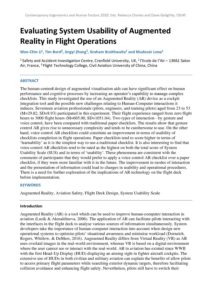| Document | Author Wen-Chin Li, Tim Bord, Jingyi Zhang, Graham Braithwaite and Mudassir Lone |
| Abstract The human-centred design of augmented visualisation aids can have significant effect on human performance and cognitive processes by increasing an operator’s capability to manage complex checklists. This study investigated the use of an Augmented Reality (AR) device as a cockpit integration tool and the possible new challenges relating to Human-Computer interactions it induces. Seventeen aviation professionals (pilots, engineers, and training pilots) aged from 23 to 53 (M=29.82, SD=8.93) participated in this experiment. Their flight experience ranged from zero flight hours to 3000 flight hours (M=605.00, SD=1051.04). Two types of interaction - by gesture and voice control, have been compared with traditional paper checklists. The results show that gesture control AR gives rise to unnecessary complexity and tends to be cumbersome to use. On the other hand, voice control AR checklists could constitute an improvement in terms of usability of checklists completion in flight operations. Paper checklists tend to score higher in terms of ‘learnability’ as it is the simplest way to use a traditional checklist. It is also interesting to find that voice control AR checklists tend to be rated as the highest on both the total score of System Usability Scale (SUS) and in terms of ‘usability’. These phenomena are consistent with the comments of participants that they would prefer to apply a voice control AR checklist over a paper checklist, if they were more familiar with it in the future. The improvement in modes of interaction and the presentation of information could lead to changes in usability and operational procedures. There is a need for further exploration of the implications of AR technology on the flight deck before implementation. |

